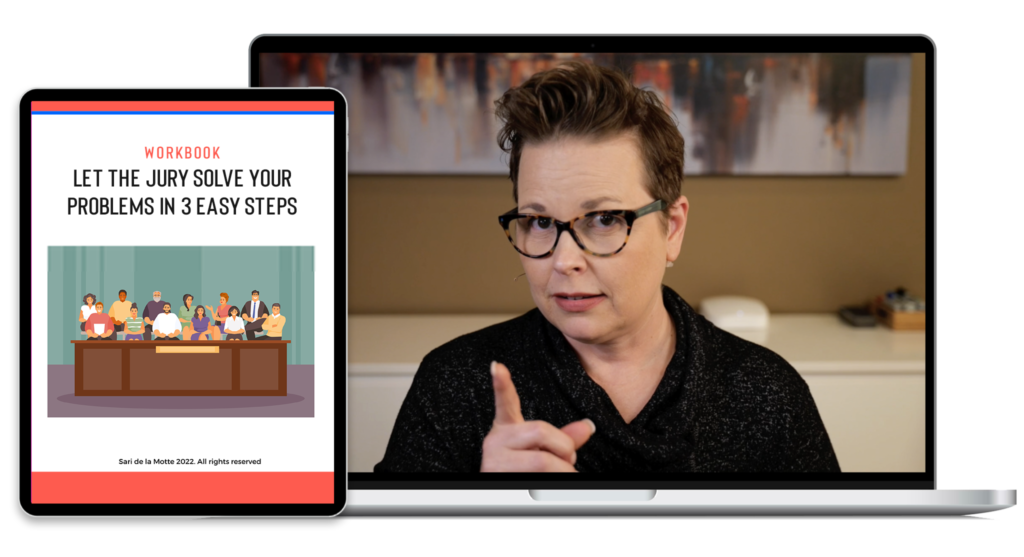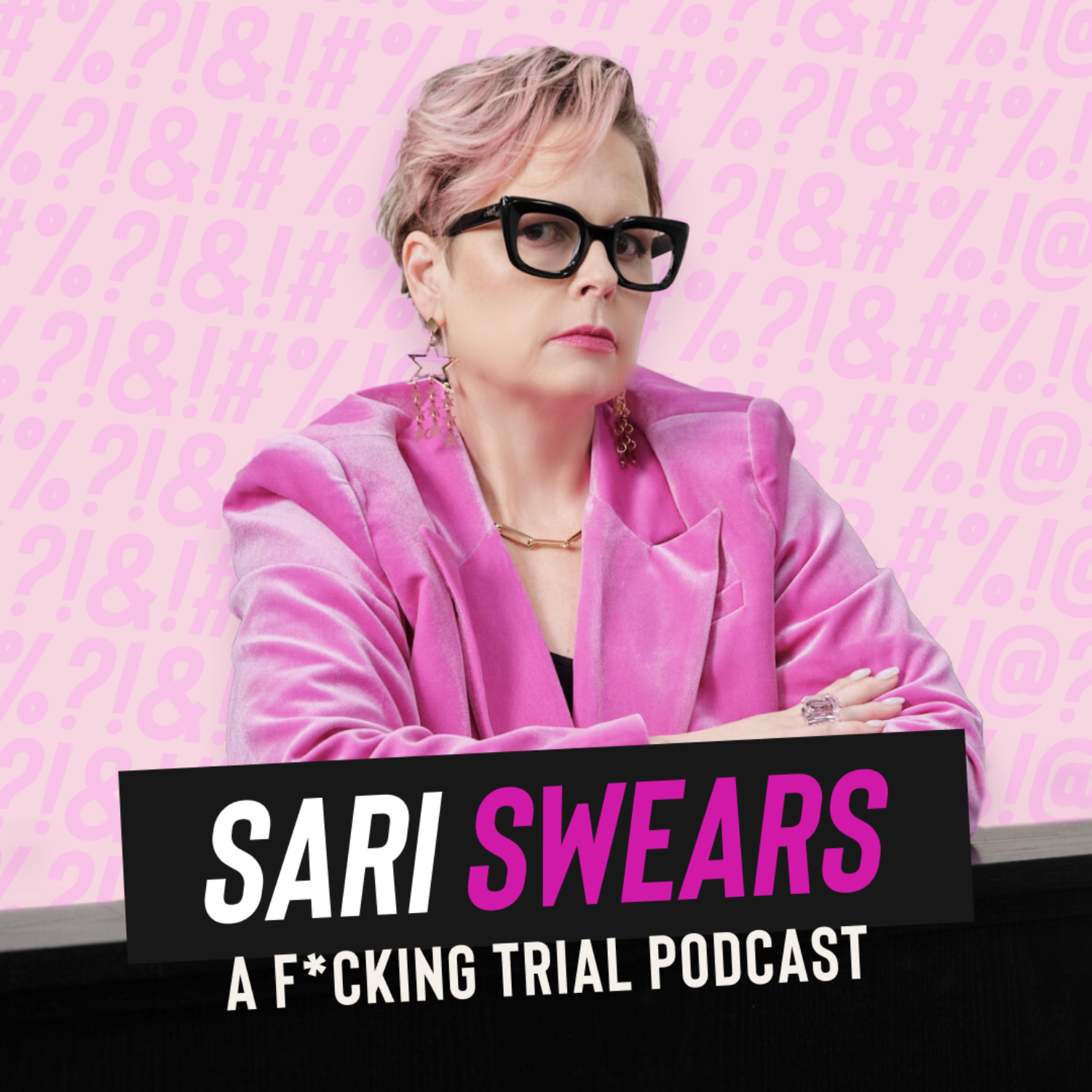In today’s podcast, I’m diving into why documented processes (yeah, those boring SOPs you’ve been avoiding) are actually the secret to scaling your practice and getting your damn life back.
? Stop micromanaging.
? Stop re-explaining.
✅ Start running your firm like a CEO.
Xo,
Sari
➡️FREE FB GROUP FOR PLAINTIFF & CRIMINAL DEFENSE ATTORNEYS
“‘Why can’t people read my mind?’ I mean, you don’t say that, but that’s really what you’re wanting people to do. And so my answer to that is, because you haven’t told them how to read your mind. Here is the big secret when it comes to getting people to read your mind: write it the fuck down. There it is. If you want people to be able to read your mind, you’ve got to write it down."
sari de la motte
encore EPISODE TRANSCRIPTION
Well, hello, how are you? I hope you're doing well. I am doing great. All right. Well, we're going to start today with a reader shout-out from Trial Guides. This is Jenny Lee, and she gives it five stars, titling it, “free yourself, free the jury,” and a very short review saying, “read it, then read it again.” Well, thank you, Jenny Lee. I so appreciate that. And if you have not reviewed the book yet, please do so at trialguides.com, and of course, review the podcast as well.
Well, today we’re talking about how to get people to read your mind, because it’s possible and doable. And as the Crew has been working all last quarter on what their—first of all, what their zone of genius is and how to manage their upper limit problem. And if you don’t have any idea what I’m talking about, go back—I have two podcasts on those very things: the zone of genius and upper limit.
But if you join the Crew, you can take all of the training that we’ve done on that.
And here’s the basic gist: your zone of genius is one of four zones.
The first zone is your zone of incompetence—these are things that you’re not good at and you should not be doing.
Then you have your zone of competence—those are things that you can do, but anyone else can do them just as well, if maybe better than you.
Then you have your zone of excellence—this is your danger zone. Why?
Because you’re good at these things, but they’re not in your zone of genius. But we tend to stay in this zone because it’s literally the comfort zone. We’re doing good things, we’re doing good work, but it’s not really pushing us, and it’s not really requiring a lot of us.
But it really is a seductive zone to stay in, because your zone of genius is now things you’re uniquely suited to do and that you love.
But your zone of genius takes a big leap. That’s where we get this concept from Gay Hendricks’s book, The Big Leap. To get there, it takes a lot of risk, it takes going out on a limb, and a lot of people aren’t willing to do that, so they stay in their zone of excellence.
But in the Crew, we’ve been working on, again, what the zone of genius is and how to get there. So I’ve done a couple trainings on that, but in particular we’ve run up against the issue—which I knew we would—of, “Okay, I know what my zone of genius is now, but how do I deal with all of the other things that I no longer want to do, that are in my zone of competence or zone of excellence, so that I can be spending 70% plus—which is what we suggest—in my zone of genius?”
And so we’ve done a training on how to create the culture that you want at your firm or, if you’re working for someone else, that you want between you and your paralegal. And we’ve had trainings on that and how to create job postings and job descriptions and all the things.
But here’s the one thing that I hear from people all the time, even before or outside of the concept of zone of genius: you all are irritated that people aren’t doing things the way that you would do them or the way that you told them to do it, so on and so forth.
So this is keeping you in your zone of genius because you don’t want to let go of that control because you’re worried that they’re not going to do it the same way that you are, and then when you do let go of that control, they still don’t do it the way that you told them to do it.
And you come to me in sessions or in the Crew and you’re like, “Why can’t people read my mind?” I mean, you don’t say that, but that’s really what you’re wanting people to do.
And so my answer to that is, because you haven’t told them how to read your mind. Here is the big secret when it comes to getting people to read your mind: write it the fuck down. There it is. If you want people to be able to read your mind, you’ve got to write it down.
Now, what do I mean by that? Well, here at Sari DLM, we are going through a process right now—this entire year we’re taking to document every last process for every single thing we do. I mean, every single thing we do. And I’m going to walk you through today how to do it for your own company if you’re the leader, or for you and your paralegal if you work for someone else. But first, let’s talk about why this is so important.
When you document processes—whether that’s “Here’s how we handle a client intake,” or “Here’s how I’d like a brief written,” or “Here’s how I’d like you to answer discovery”—so many of you are now moving out of where you have been working in the law for 10, 15 years and wanting to take on bigger cases, wanting to work more on trial prep, but you’re still swimming in all the day-to-day, and you want to hire an associate, but you’re worried that they won’t do it like you will.
Well, here’s how you get them to do it like you will: you write that shit down, and you document the process, and you say, “Here is how this works. Step one, step two, step three.”
Because when you keep coming to me and saying, “Listen, I hired this person and I told them how to do it, but they don’t do it the way that I want them to do it, and so then I’m all frustrated,” here’s what’s happening. You’re saying to me, “Well, I told them how to do it.” But if this person is new, particularly, and you told them, you probably told them 500 other things too. They can’t possibly hold all that in their head. So when you document what you want and how you want it done, it does a variety of things.
One, it creates something that you can evaluate people on.
It’s really tough when you hire somebody and you say, “Do it this way,” and then they don’t do it this way, and you’re like, “Why didn’t you do it this way?” They say, “Well, I thought you said this,” or “I had this problem,” or whatever, and so you’re constantly swirling, trying to manage what’s happening. When you have a process, one of two things is amiss when it doesn’t go the way you want: you either didn’t write the process correctly—you missed a step—or the person is choosing not to follow it, which means they’re not the right person, and you need to get rid of them. It really is that simple.
When you have a process and it’s documented, people can go and look at it and follow it, and if there’s an issue, you can edit the process, or there’s something on their end, but it makes it really super clear. Nothing is missing in the communication because it’s documented.
The second reason that you want a process, so that you document absolutely everything in your world and how you do it, is it now allows anyone to come in and do that thing.
So many of you don’t want to go on vacation or you’re afraid to go on vacation because there’s going to be so much work piling up for you, or you hire somebody and they go on maternity leave and now you don’t know what to do for the next two months—all of the things. When you have a documented process, you can go on vacation and you can feel confident knowing that things are being handled. Why? Because there’s a process that people can follow. If someone goes on maternity leave, if somebody leaves, if you fire somebody—these all happen in your firm or with you in a paralegal or legal assistant—you have a documented process that someone can come in immediately and have access to and be up and running very, very quickly.
The third reason that you want a process—there’s probably more than three, but you know that I love my threes—is that when you have a documented process and you’ve written down what and how you want things to be done—and yes, and how—it reduces the amount of meetings that you have to participate in.
So many of you are just drowning in meetings, and it’s because people have all these questions for you, and they’re not sure how to do things, and they need feedback. When you have a documented process, it reduces that by half, if not more, because now you can just direct people back to the process. And if you still have to meet, the meetings can be much, much shorter.
So if I haven’t convinced you already that you need processes, there are the three really, really good reasons.
You can use it to evaluate, it cuts down on communication issues, and you can identify what the problem is immediately—it’s either the process or the person. That’s your first reason. Your second reason is anybody can do anybody’s job—vacations, maternity leave, whatever it may be, firing, hiring—you’ve got a process, and it’s documented. And the third reason is it cuts down on meetings, because everything is somewhere that people can find it.
So now let’s talk about the practical way to do this. And if you’re like, “Well, what does this have to do with trial skills?” I want you focusing on your zone of genius. That is going to create a better world, which I’m all about. You cannot be in your zone of genius, doing what you are uniquely suited to do and what you love doing, if you’re constantly dealing with all the shit that you shouldn’t have to be dealing with. Most of you are in a position now—at least my main audience, I don’t mean to leave anybody out—but most of my clients are in a position now where they can start taking the cases they want to take and doing the things they want to do, but you have to have some systems in place before you get there.
All right, so here are the ways that you want to think about a process. You want to think of it in terms of front-stage and backstage.
All right, so your front-stage process is what your client is experiencing. So when a client comes to you, what you’re going to do is you’re going to create a narrative. You’re going to walk through the eyes of a client of how they get to you. By the way, your marketing people, if they’re not already doing this, they should be—get new marketing people if you don’t have a marketing department. You’re going to hire one. They’re going to love that you have done this. But good marketers know this is the track. And so if you have a good one, you can go and ask them, “What’s our customer narrative? What’s the front-stage process? How do they get to us?”
So it might be they see a billboard, or they Google you. So what you’re saying, you’re coming from the client perspective, and you’re documenting this process. So you’re saying step one: client sees or Googles trial lawyers in Philadelphia. Step two: my website comes up. Step three: they click on the website. Step four: the chat box comes up—says, “Hey, can I help you?” Step five: they tell us what they need. Step six: they set up a consultation. Step seven: the consultation occurs over the phone. We get this information, step eight, and you continually go down that process. You might have another process for handling discovery. You might have another process for writing a brief. You might have another process for scheduling a deposition. You might have all kinds of processes, but let’s just go through the customer one right now, or the plaintiff, or the client one. That’s your front-stage process, and you’re going to walk that all the way through—all the way through trial, if it ends up going to trial, and even after trial.
Why do you care about the client after trial? Because, well, we want to care, but also if they know people that need your help, we want them to have a good experience all the way through—before they meet you, during the time they’re with you, and after. So you’re going to have three stages of that process: before, during, and after. Now, that’s your front-stage.
Your backstage process is you go back to your front-stage, and you see what needs to happen for each of those steps. So if step one was “They Google plaintiff attorney in Philadelphia and my website comes up,” there’s a process. How does your website come up? What’s the process for that? Are you running Google Ads? Are you creating SEO? There’s a whole process for making sure that they find you in their Google search in the first place. So that would be its own backstage process—just that step one and two.
Step three, “They click on my website and they see X.” There’s its own process. “Okay, the website needs to have X up, and here’s how we get that up, and here’s how we update that, and here’s our process for that.” Chat box comes up—there’s a whole process for that. “They schedule a consultation”—whole process for that. “We get their phone number; we use this particular calendaring system. This person handles it. This is how long the call is. This is the information we get on the call. This is the next step.” So each one of your parts of the narrative is going to have a backstage process.
Now, at this point in the podcast, you’re thinking, “Oh my God, this is a lot of work.” It is, absolutely, at the beginning. It’s why we’re taking a whole year to do this for every absolute—every process we have in our business. But once you have this, it becomes one of your greatest assets, because now you’ve got something that’s repeatable, editable, and it grows with you. You can go back and look at your processes and create new ones, delete them, edit them as you continually grow. But anybody can come in and do anybody’s job. And then there’s none of this, “Well, I told you.” “Well, I didn’t hear that.” It’s right there. And you can have a process for anything.
I have a multi-page process for how I like my travel to be booked—multi-page. Why? Because then there’s no misunderstandings. I’m a diva. I get it. I have back problems. I want specific things like a bathtub in my hotel room because travel’s really hard on my back. I need to go first class again because travel’s really hard on my back. I need this and that, and this type—I need a certain kind of car because, again, travel’s really hard on my back, and I need to sit up straight. I could tell all that to my assistant, and she could get it wrong, and I’d get mad at her, but it’d be my fault because I’m expecting her to read my mind. Instead, I have a multi-step process, and she can go through that process, and she doesn’t have to ask me questions, and I don’t have to spend my time reminding her every time, “This is what I need.” It’s there in the process. And if something doesn’t happen, then there’s something either wrong with the process or wrong with the person, and you can deal with it instead of having this nebulous “I don’t know what’s going on with this employee, and it’s not working out.”
Now, how do you document that process? We’re particularly using Asana, which is a project management software, and I’m going to suggest that you pick whatever you like, but two things it needs to have: it needs to have a video capability, and it needs to have text capability—not texting, but to create the process in writing. And that’s how we document most of our processes, is that they’re going to be in writing, but there’s also going to be video tutorials, because you can get a lot more from video than just the written, but we’re going to have both.
Now, again, is it a lot of work? Yes, but I consider this a huge asset of my business—huge. If I ever want to sell my business—I don’t think I ever will—huge asset to have these processes, absolute asset.
But the biggest thing in today’s podcast is all about making it easier for you to get into your zone of genius. How do you get people to read your mind? Write it the fuck down.
All right, report back. Let me know how it’s going. Talk soon.
Have you ever wished you knew what the jury was thinking? Well, grab a pen and paper because I’m about to give you instant access to a free training I created for plaintiff trial attorneys. It’s called Three Powerful Strategies to Help You Read a Juror's Mind, and it will help you understand what the jury is thinking so you can feel confident and trust yourself in the courtroom.
Ready? Head to sariswears.com/jury and enjoy!


Free Training
3 pOWERFUL STRATEGIES TO HELP YOU READ A JUROR'S MIND
Let the Jury Solve Your Problems in 3 Easy Steps
Join me for a free training to understand what the jury is thinking so you have the confidence to trust them - and yourself - in the courtroom.
Use the H2H Funnel Method so that jurors tell YOU the principles of the case instead of you telling THEM.

Subscribe to the Podcast
Tune in weekly as Sari shares tips that will help you up your game at trial, connect with jurors, and build confidence in your abilities so that you’ll never worry about winning again.
Sign up for trial tips, mindset shifts, and whatever else is on Sari’s brilliant fucking mind.




